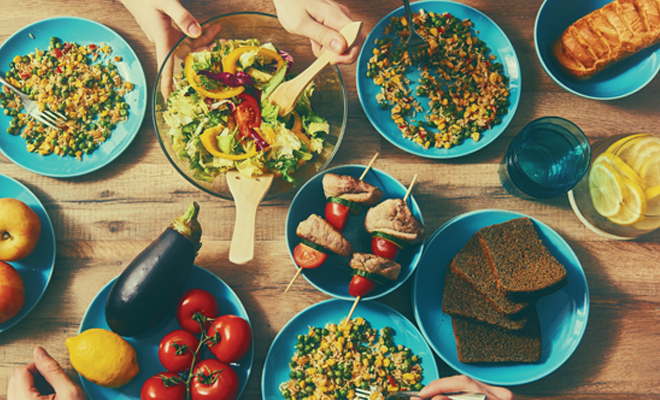
The Key to Healthy Homemade Meals? Your Freezer!
In a recent survey, we asked our readers, “What’s your biggest obstacle to getting a healthy meal on the table?” Close to 1,000 people responded, “Not enough time.” As working moms with three kids each, we know the tension of wanting to feed our families well yet being pinched for time. That’s exactly why Polly and I have become freezer cooking fanatics. Don’t turn your nose up just yet as you envision old school TV dinners.
Preparing meals in bulk and freezing them for later has helped us eat healthier, save time and money and enjoy less-stressful family dinners. Here’s the biggest surprise: freezer meals can taste just like a fresh meal if prepared correctly.
1. Use high-quality fresh ingredients that stand up well to freezing and thawing.
The first rule of freezer cooking is that what you put in is what you get out. If an ingredient didn’t taste good to begin with, it won’t be better after freezing. Refer to our cookbook, From Freezer to Table, for a list of which foods do best and worst in the freezer.
2. Consider freezing a meal before it’s been cooked.
Dishes such as casseroles, marinated meats and baked oatmeal taste best when frozen before they are cooked. Most of our recipes will instruct you to prepare meals up to the point of cooking them. However, many soups, baked goods and cooked shredded meat in a sauce taste fine when frozen after cooking.
3. Store in an airtight, freezable container.
From freezer bags to rigid containers to Mason jars, there are multiple freezer storage options. Whatever method you choose, the goal is to prevent the food from being exposed to air, which can result in freezer burn. While it isn’t harmful to eat freezer-burned food, the texture and flavor can be adversely affected. Wrapping food tightly in plastic wrap and foil can also help protect food from air exposure.
4. Freeze quickly and at the right temperature.
Slowly-frozen food forms large ice crystals that may turn food mushy and cause freezer burn. Try these tips to freeze food fast:
• Chill cooked dishes before freezing. To safely bring down the
temperature, place partially cooled food in a shallow, wide container and refrigerate, uncovered, until cold.
• Store all foods at 0° F or lower to retain vitamin content, flavor, texture and color.
• Do not crowd the freezer so there is enough room for air to circulate around food.
• Store foods in smaller servings, when possible.
5. Follow recommended storage times for freezing meals.
We generally recommend that a freezer meal be used within three months. However, if your food has been frozen at 0° F and is wrapped tightly, we’ve found that meals can still be in good shape six to nine months out.
6. Thaw frozen food properly.
Let’s begin with the most important principle: no thawing on the counter! This can put perishable food within a temperature range at which harmful bacteria grow at a rapid pace. Instead, use one of these safe thawing methods:
• Refrigerator. Our preferred method.
• Cold water bath. Seal the food tightly and change the water every 30 minutes.
• Defrost setting on the microwave. Least preferred method but works in a pinch.
Get started eating healthier in 2020 by preparing some freezer-friendly recipes from our cookbooks or ThrivingHome.org. ■
Written by: Polly Conner and Rachel Tiemeyer
Polly Conner and Rachel Tiemeyer are the founders of Thriving Home, a down-to-earth lifestyle blog they began in 2012 as a way to encourage and equip moms in the day-to-day challenges that come with raising a family. Thriving Home has risen to the top as a leader in the online freezer cooking space, and these time-strapped moms of three (each!) jokingly refer to themselves as “freezer meal evangelists.” They are the authors of From Freezer to Table (2017) and From Freezer to Cooker (January 2020), and live with their families in Columbia, Missouri.
facebook.com/thrivinghomeblog
instagram.com/thrivinghome
pinterest.com/polly827401









